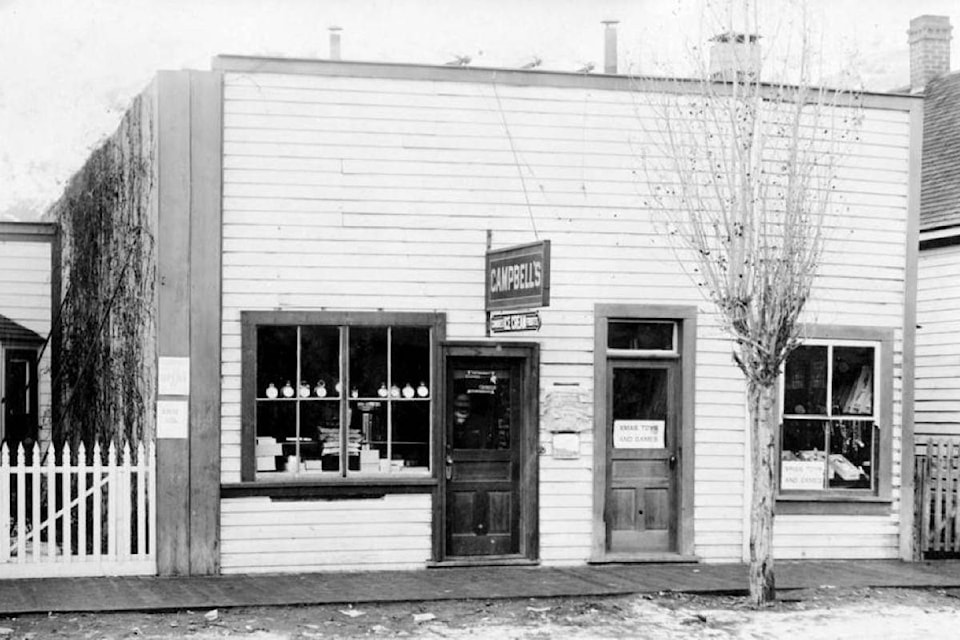As we continue our stroll down Railway Avenue in Ashcroft in 1906, we approach the ill-fated Cargile Hotel, located where the barbershop and Second Time Around now stand. Journal editor R.D. Cumming talked of the “best” (Ashcroft) and “next best” (Grand Central) hotels, but never mentions the third (would he have called it the “least best”?). This was the Cargile, which seems to have been the unloved cousin of Ashcroft hotels, perpetually struggling for business (except on occasions when a major event drew more people than usual to the town).
It was stricken by a run of bad luck. The Cargile started life as a hotel in Yale, but was then taken apart and shipped to Ashcroft for reconstruction. In March 1887, when the pieces arrived in Ashcroft and began being reassembled, residents turned out to watch; only to see the erected pieces blown over by a windstorm, due to a lack of nails to hold the pieces together.
The hotel was rebuilt, and opened in July 1887; but in August of that year a fire started in the kitchen, and the hotel burned to the ground. It was rebuilt, only to fall victim to fire again in 1892, with the loss of one life.
It was rebuilt again, and in 1906—as we pass by—it still stands near the north end of Railway. The owners were not to know that it would be burned down again, in the Great Fire of 1916, after which time the Cargile Hotel ceased to exist.
We are taking our stroll in May, when skating and curling are far from everyone’s mind. However, before a curling rink was built in Ashcroft just before World War I, the CPR water tank at the north end of town was used to flood Railway Avenue in front of the Cargile, providing an ice surface for skaters and curlers.
Hot cinders from the passing CP trains would frequently land on the ice and create pockmarks. The skaters never seemed bothered, but the curlers got very annoyed, as they never knew when their rocks would hit a cinder and come to a sudden stop.
South of the Cargile is Gibson’s Meat Market, which was built in 1895; in that same year a Mrs. Glencross opened a restaurant in the building. Beyond the Cargile we can see the Inland Feed Store, where Safety Mart now stands. It was one of several firms in town—including Stewart’s and Crozier’s—which catered to the horses which were the lifeblood of the area until automobiles began making their slow but steady inroads into the Interior, precipitating the decline and end of the stagecoach lines.
Across the street is Ashcroft’s Chinatown, a cluster of businesses catering not only to the large Ashcroft Chinese community but to the white settlers as well. A Chinese man named Lin Kee opened one of the first businesses in Ashcroft in the 1880s, and in 1892 Chow Sing opened the Wing Chong Tai—“Forever Great Prosperity”—store, near where the car wash stands today. It was to be a fixture of Railway Avenue for nine decades, and remained in the hands of the Chow family for four generations. Chow Jim operated the Club Restaurant, and the Loy brothers had opened the Wing Wo Lung store, just down the street from Wing Chong Tai.
There were two other general stores, belonging to Lin Kee and Hop Wo, and a reading room beside Wing Chong Tai. Wah Lee had a laundry at the north end of Railway; in an ominous foretelling of things to come, it burned down in January of 1915.
As we head north past Chinatown we come to a shoe store, which dates from the 1890s, for in 1895 it was reported that someone made off with a pair of boots from the shop, only to return them some time later and ask if they could be repaired. Beside the shoe shop is George Stewart’s harness and saddlery shop, built in 1899.
We come to the CP station and depot, where Fields now stands. In 1906, Ashcroft was the northernmost rail destination in the province, so any people or goods travelling to or from the north passed through the town. As a result, the station and depot are hives of activity, with travellers coming and going, stagecoaches unloading passengers and freight and taking up new loads, and teams of oxen offloading goods from the north and taking on new loads that will be transported up the Cariboo Road.
And now, as it’s a warm day and we deserve a treat after our walk, we’ll double back on ourselves and head towards the Central Hotel, stopping just to the north of it to pop into Campbell’s Ice Cream Parlour, Confectioner’s, and Tobacconist Shop. It was located in what’s now the empty lot beside the Central, and is quite possibly the spot where a Mrs. Steadman installed Ashcroft’s first soda fountain in 1899.
There’s a tempting display of confectionery in glass jars behind the soda fountain; the tobacco isn’t readily apparent, but the proprietors also sold a good many other items, some of them not what you’d expect to find in an ice cream parlour.
The ice cream itself would have been a rather exotic novelty, back in those days before easy refrigeration and freezing, and the proprietors almost certainly took advantage of the ice stored in the icehouse at Foster’s store up the street, especially in summertime, when a trip to Campbell’s for ice cream would have been a deliciously cool treat on a warm Ashcroft spring day.
And there we have it: the final part of a stroll down a bustling Railway Avenue in 1906. Sometimes, when I drive downtown, I try to picture it as it was more than a century ago. Time travel is (sadly) not yet a thing; but if I try hard, I can get a glimpse of what used to be.
editorial@accjournal.ca
Like us on Facebook and follow us on Twitter
